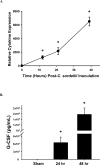A novel murine model of Clostridium sordellii myonecrosis: Insights into the pathogenesis of disease
- PMID: 26805011
- PMCID: PMC4775425
- DOI: 10.1016/j.anaerobe.2016.01.004
A novel murine model of Clostridium sordellii myonecrosis: Insights into the pathogenesis of disease
Abstract
Clostridium sordellii infections have been reported in women following natural childbirth and spontaneous or medically-induced abortion, injection drug users and patients with trauma. Death is rapid and mortality ranges from 70 to 100%. Clinical features include an extreme leukemoid reaction, the absence of fever, and only minimal pain or erythema at the infected site. In the current study, we developed a murine model of C. sordellii soft tissue infection to elucidate the pathogenic mechanisms. Mice received 0.5, 1.0 or 2.0 × 10(6) CFU C. sordellii (ATCC 9714 type strain) in the right thigh muscle. All doses caused fatal infection characterized by intense swelling of the infected limb but no erythema or visible perfusion deficits. Survival rates and time to death were inoculum dose-dependent. Mice developed a granulocytic leukocytosis with left shift, the onset of which directly correlated with disease severity. Histopathology of infected tissue showed widespread edema, moderate muscle damage and minimal neutrophil infiltration. Circulating levels of granulocyte colony-stimulating factor (G-CSF), soluble tumor necrosis factor receptor I (sTNF-RI) and interlukin-6 (IL-6) were significantly increased in infected animals, while TNF-α, and IL-1β levels were only mildly elevated, suggesting these host factors likely mediate the leukocytosis and innate immune dysfunction characteristic of this infection. Thus, this model mimics many of the salient features of this infection in humans and has allowed us to identify novel targets for intervention.
Keywords: C. sordellii; Host immune response; Leukemoid reaction; Myonecrosis; Pathogenesis.
Published by Elsevier Ltd.
Conflict of interest statement
Figures






References
-
- Aldape MJ, Bryant AE, Stevens DL. Clostridium sordellii infection: epidemiology, clinical findings, and current perspectives on diagnosis and treatment. Clin Infect Dis. 2006 Dec 1;43(11):1436–46. - PubMed
-
- Sicard D. Deaths from Clostridium sordellii after medical abortion. N Engl J Med. 2006 Apr 13;354(15):1645–7. - PubMed
-
- Sinave C, Le TG, Blouin D, Leveille F, Deland E. Toxic shock syndrome due to Clostridium sordellii: a dramatic postpartum and postabortion disease. Clin Infect Dis. 2002 Dec 1;35(11):1441–3. - PubMed
-
- Smith LDS. Clostridium sordellii. In: Smith LDS, editor. The pathogenic anaerobic bacteria. Springfield, IL: Charles C. Thomas Publishing; 1975. pp. 291–8.
Publication types
MeSH terms
Substances
Grants and funding
LinkOut - more resources
Full Text Sources
Other Literature Sources
Molecular Biology Databases

